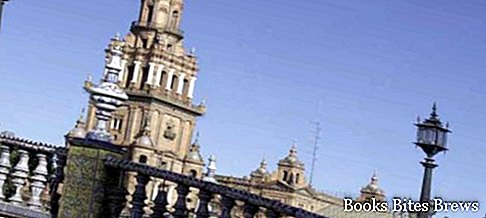What to see in Seville, itinerary including the main monuments and places of interest, including Alcazar, Cathedral, Giralda and Spanish Steps.
Tourist information
The foundation of Seville is attributed to the Tartessian people, subsequently occupied by the Phoenicians and the Carthaginians, the city was conquered by the Romans in 206 BC. The Romans, about 7 kilometers away from Hispalis, the ancient name of Seville, founded the city of Italica, corresponding to the current municipality of Santiponce, where there are the ruins of a theater, an amphitheater, houses and paved streets of the time Roman.
After the fall of the Roman Empire, Seville suffered the invasions of the Vandal, Swabian and Visigoth peoples.
From 712 to 1248 the city was dominated by the Arabs, who called it Ishbiliya, from which the current name derives.
In particular in 1147, with the Almohad dynasty in power, a period of artistic and cultural growth began, monuments such as the Torre del Oro, the Giralda, the Alcazar and the walls of the Macarena were built.
With Ferdinand III of Castile the city was reconquered by the Christians and the court of the Kingdom of Castile settled in the Alcazar, an Arab fortress, moreover mosques were converted into Christian churches and new ones were built, then in the 15th century the construction of the cathedral in the place where the mosque was located.
With the discovery of America, Seville became the richest city in Spain, the main port of connection with the new world, home to the Casa de Contratación, the commercial body that had a monopoly on merchant relations with the American colonies.
In 1929 it was the seat of the Ibero-American Exhibition and on that occasion the private gardens of the Palazzo di San Telmo, donated in 1893 by Maria Luisa Duchess of Montpensier, to the city, were transformed into the Maria Luisa Park, therefore the gardens were built and the buildings built exhibition, Spanish Steps and America Square.
What see
The Cathedral and the Reales Alcazares overlook the Plaza de la Virgen de los Reyes and Plaza Triunfo, while the neighborhoods of Santa Cruz and El Arenal are located around the nucleus of the monumental Seville, characterized by having maintained the appearance they had in the Moorish era with winding lanes, irregularly shaped squares and low houses with large and elegant patios.
The Giralda, first minaret of the mosque then bell tower of the cathedral and monument symbol of Seville, was used in the Moorish era by the muezzin to call the faithful to prayer as well as probably also having a use for astronomical observations.
Built in the last decades of the twelfth century, it has undergone various changes over the centuries and is currently one of the greatest examples of Spain's mujedar style.
Recommended readings- Spain: travel story between Toledo, Andalusia and Madrid
- Barcelona (Spain): what to see in the capital of Catalonia
- Puerto de la Cruz (Tenerife): what to see
- Balearic Islands (Spain): useful information
- Formentera (Spain): what to see on the Balearic island
With a height of 103 meters, it is visible from many parts of the city and on its top houses the Giraldillo which represents the Triumph of Faith.
The Cathedral is the largest in Spain, in order of size, and the third in the world, after San Pietro in Rome and San Paolo in London.
It was built at the place where the great mosque stood, of which the Giralda and the Patio de los Naranjos remain.
The main facade is located along Avenida de la Constitución and the 5-nave interior is particularly striking for its vastness.
Behind the choir located in the central nave stands out the Major Chapel enclosed by a remarkable wrought iron railing beyond which there is an immense altarpiece. Furthermore, in this church there is also the mausoleum of Christopher Columbus.
The Reales Alcázares, which translated means royal fortresses, consist of an architectural ensemble ranging from the first Arab Alcázar to the subsequent extensions of courtyards and palaces that were built by the subsequent monarchs.
The Barrio of Santa Cruz represents one of the most picturesque neighborhoods of Seville, located in the center and with a Moorish structure, made of narrow and quiet streets where beautiful houses overlook the walls of the white and ocher facades covered with flowers and ivy.
At the time of King Ferdinand III, after the expulsion of the Arabs, the Jewish community moved here.
The Torre de Oro is an ancient surveillance tower located on the banks of the Guadalquivir river, built by the Almohadi in the early thirteenth century to have control over navigation.
The tower, which houses the naval museum, has a dodecagonal plan and consists of two bodies, one of which in stone and one in brick.
The House of Pilate is located in the square of the same name and was built in the sixteenth century by the wish of Don Fadrique who, as soon as he returned from the Holy Land, wanted to see a copy of the Praetorium of Pontius Pilate, procurator of Judea.
The building mixes different architectural styles ranging from the Renaissance to the Mudejar style typical of Andalusia.
Parco Maria Luisa is the most beautiful green area in Seville, the result of the donation to the city by the owner Princess Maria Luisa of half the gardens of the San Telmo Palace.
Piazza di Spagna is a gigantic semicircular square two hundred meters wide with two tall towers at its ends.
In the center there is a navigable canal and along its perimeter there are arcades with balustrades and benches decorated with beautiful majolica tiles depicting each of the 54 Spanish provinces.




